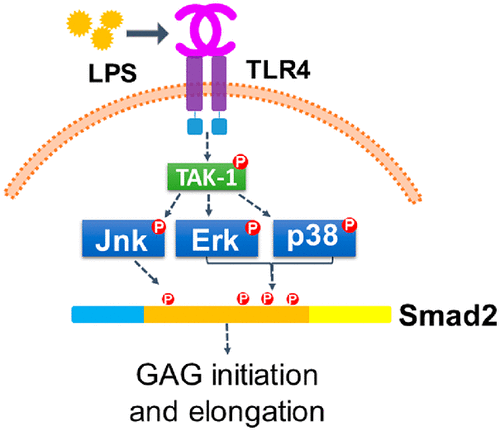当前位置:
X-MOL 学术
›
ACS Pharmacol. Transl. Sci.
›
论文详情
Our official English website, www.x-mol.net, welcomes your feedback! (Note: you will need to create a separate account there.)
Toll-like Receptor 4 Stimulates Gene Expression via Smad2 Linker Region Phosphorylation in Vascular Smooth Muscle Cells.
ACS Pharmacology & Translational Science Pub Date : 2020-03-11 , DOI: 10.1021/acsptsci.9b00113 Rizwana Afroz 1 , Ying Zhou 1 , Peter J Little 1, 2 , Suowen Xu 3 , Raafat Mohamed 1, 4 , Jennifer Stow 5 , Danielle Kamato 1, 2
ACS Pharmacology & Translational Science Pub Date : 2020-03-11 , DOI: 10.1021/acsptsci.9b00113 Rizwana Afroz 1 , Ying Zhou 1 , Peter J Little 1, 2 , Suowen Xu 3 , Raafat Mohamed 1, 4 , Jennifer Stow 5 , Danielle Kamato 1, 2
Affiliation

|
Atherosclerosis begins in the vessel wall with the retention of low density lipoproteins to modified proteoglycans with hyperelongated glycosaminoglycan (GAG) chains. Bacterial infections produce endotoxins such as lipopolysaccharide that exacerbate the outcome of atherosclerosis by generating a heightened state of inflammation. Lipopolysaccharide (LPS) via its toll-like receptor (TLR) is well-known for its role in mediating an inflammatory response in the body. Emerging evidence demonstrates that TLRs are involved in regulating vascular functions. In this study we sought to investigate the role of LPS in proteoglycan modification and GAG chain elongation, and we hypothesize that LPS will signal via Smad2 dependent pathways to regulate GAG chain elongation. The in vitro model used human aortic vascular smooth muscle cells. GAG gene expression was assessed by quantitative real-time polymerase chain reaction. Western blotting was performed using whole-cell protein lysates to assess the signaling pathway. LPS via TLR4 stimulates the expression of GAG synthesizing enzymes to an equal extent to traditional cardiovascular agonists. LPS phosphorylates the Smad2 linker region via TAK-1/MAPK dependent pathways which correlated with genes associated with GAG chain initiation and elongation. The well-characterized role of LPS in inflammation and our data on GAG gene expression demonstrates that GAG chain elongation is the earliest marker of the inflammatory cascade in atherosclerosis development.
中文翻译:

Toll样受体4通过Smad2接头区域磷酸化刺激血管平滑肌细胞中的基因表达。
动脉粥样硬化始于血管壁,其中低密度脂蛋白保留在具有超长糖胺聚糖(GAG)链的修饰蛋白聚糖上。细菌感染会产生内毒素,例如脂多糖,会通过加剧发炎状态而加剧动脉粥样硬化的结果。通过其通行费样受体(TLR)形成的脂多糖(LPS)以其在体内介导炎症反应的作用而闻名。新兴证据表明,TLRs参与调节血管功能。在这项研究中,我们试图研究LPS在蛋白聚糖修饰和GAG链延长中的作用,并且我们假设LPS将通过Smad2依赖性途径发出信号以调节GAG链延长。在体外该模型使用人主动脉血管平滑肌细胞。通过定量实时聚合酶链反应评估GAG基因表达。使用全细胞蛋白裂解物进行蛋白质印迹以评估信号传导途径。通过TLR4进行的LPS刺激GAG合成酶的表达与传统心血管激动剂相同。LPS通过TAK-1 / MAPK依赖性途径使Smad2接头区域磷酸化,该途径与与GAG链起始和延伸相关的基因相关。LPS在炎症中的作用已得到充分认识,我们关于GAG基因表达的数据表明,GAG链延长是动脉粥样硬化发展中炎症级联反应的最早标记。
更新日期:2020-03-11
中文翻译:

Toll样受体4通过Smad2接头区域磷酸化刺激血管平滑肌细胞中的基因表达。
动脉粥样硬化始于血管壁,其中低密度脂蛋白保留在具有超长糖胺聚糖(GAG)链的修饰蛋白聚糖上。细菌感染会产生内毒素,例如脂多糖,会通过加剧发炎状态而加剧动脉粥样硬化的结果。通过其通行费样受体(TLR)形成的脂多糖(LPS)以其在体内介导炎症反应的作用而闻名。新兴证据表明,TLRs参与调节血管功能。在这项研究中,我们试图研究LPS在蛋白聚糖修饰和GAG链延长中的作用,并且我们假设LPS将通过Smad2依赖性途径发出信号以调节GAG链延长。在体外该模型使用人主动脉血管平滑肌细胞。通过定量实时聚合酶链反应评估GAG基因表达。使用全细胞蛋白裂解物进行蛋白质印迹以评估信号传导途径。通过TLR4进行的LPS刺激GAG合成酶的表达与传统心血管激动剂相同。LPS通过TAK-1 / MAPK依赖性途径使Smad2接头区域磷酸化,该途径与与GAG链起始和延伸相关的基因相关。LPS在炎症中的作用已得到充分认识,我们关于GAG基因表达的数据表明,GAG链延长是动脉粥样硬化发展中炎症级联反应的最早标记。


























 京公网安备 11010802027423号
京公网安备 11010802027423号